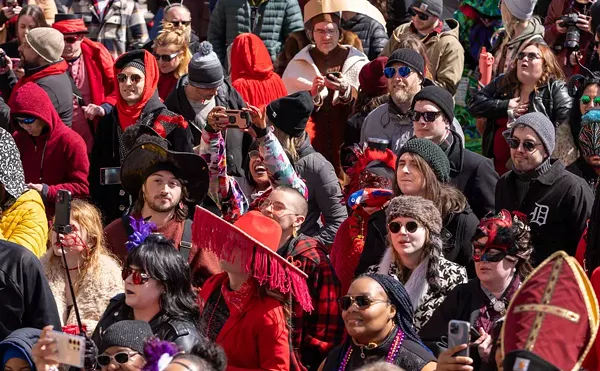The trash bin in the alley behind Golden Hill, in Hamtramck, belongs to Al Capone. It's tough to say how long he's been there, maybe about a year. That coy gal probably came with him. A little ways down the alley is Honest Abe with a broken nose. You'll find George "Eat Shit" Bush across the street from Polish Market, off Joseph Campau. In Cass Corridor's mini-Chinatown, Tina Tuner takes Peterboro.
Stenciling as a form of graffiti made its mark in this city decades ago, say veteran Detroit artists. For a reference, Tim Caldwell points to Dave Roberts, who advises a phone call to Billy O'Bryan, who rambles for a while before admitting he stenciled extensively while living in Japan. Roberts recalls upon pressing that him and O'Bryan "went out in Detroit on a couple of forays." Their handiwork was even pictured on the cover of Metro Times back in the mid-'80s. He also says back then Cranbrook alum and fellow Willis Gallery director Robert Crise Jr. used spray paint and stencils to the create such imagery as jet fighter planes.
"As graffitti became recognized on the East Coast and then in the art journals, people became concerned with aesthetics," Roberts says. "Prior to that, stenciling was more message-oriented. In those early days, a lot of people had hope that the graffitti wave was the start of something new and big, that things would really change here. Then another recession hit and it was over for a while."
For God-knows-how-many-years in between then and now, our city's stenciling has consisted of stupid Atari-style Froggers, Pac-Man ghosts and fetus-feeding aliens on warehouses and freeways. Aside from the occasional anomoly like Obey, Alfred E. Neuman's mug on Mother's Bar, the legacy of Trumbullplex and the anarchy "A," the stuff was as lame and laissez-faire as the Ronald Reagan era it once railed against.
But now, on the southwest side, a man in a sombrero shares space with Marie Antoinette, Noam Chomsky and haunting portraits of "developing" countries. Zebras mark their territory in Eastern Market along with dragonflies on lotus leaves. Mushrooms and carp crowd sidewalks and manhole covers across the city. For those who drive, walk or ride around Detroit and Hamtramck avoiding traffic lights and one-ways by shortcutting along side streets and alleyways, these additions are obvious and exciting. Someone's sending a signal.
One local leftist explains that unlike poster and wheat paste, spray paint can withstand the harsh climate. And like a stamp or a Xerox, stenciling is art of the people with a pattern or process that can be recycled by many. Sharing traits with printmaking (with prehistoric roots and direct links to ancient Chinese tapestries and textiles), the repetitive mark-making well represents anti-capitalist and anti-militaristic ideas: Don't promote the vanity or authority of artist as individual.
Through a local artist, we've come in contact with an anonymous stenciler named S.O.S. (an acronym for "survivor on shore") who claims responsibility for some of the linear-looking environmental and political imagery sprayed on the scene since last summer. And someone else we'll call Word Swallower has been keeping busy as well in southwest Detroit, specifically with portraits (Noam Chomsky is his). Recently, S.O.S., a woman who lives in Detroit, deigned to answer a few questions via e-mail.
Metro Times: What draws you to stenciling?
S.O.S.: It's outdoor anonymous art. I'm sort of against art for money. That's one kind of answer. Another is that new buildings and parking structures are so anonymous — that word again but in a different context. There's the effort to make art site-specific too, which draws one to the great outdoors. Image and color on a mundane architecture can make it seem more alive. By putting an image on the building, it challenges the existence of the building.
Then there's the idea of art giving remedy to decay — that it will bring hope and renewal to blight. I agree, and it gives evidence that there are eyes and ears and soul in seeming forgotten spaces, but I don't agree it's the only place for graffiti.
MT: Why have you chosen animals and plants? Can you explain how, if at all, this particular imagery is political (perhaps environmental politics)?
S.O.S.: Well for one thing, they humanize the building or whatever they are on. And they always have some meaning, don't they? How is it political, you ask. You might well ask: How is it not political? Some art is overtly political — but what of the rest? Is art that is not political merely turning away from it? You hear of non-political art, but isn't that like saying: "It's OK by me..." Or at least, "I can live with the situation."
With the concrete we've poured over the world, the wetlands we've filled in Michigan, I wanted to repopulate Detroit with the nature that's indigenous to this area, but no longer exists in our everyday lives. Dragonflies in the city, mushrooms cropping up on those silly plastic light protectors, fish on manhole covers — signs of virtual nature.
MT: What do you look for in a good site?
S.O.S.: Personally, I would never mark older architecture or its trimmings. Brick, marble, old light posts, all these things I consider off-limits. Mainly boarded-up windows, wood and various concrete surfaces — they seem to be best for stencils, and it's kosher historically.
Rebecca Mazzei is Metro Times arts and culture editor. Send comments to [email protected]





